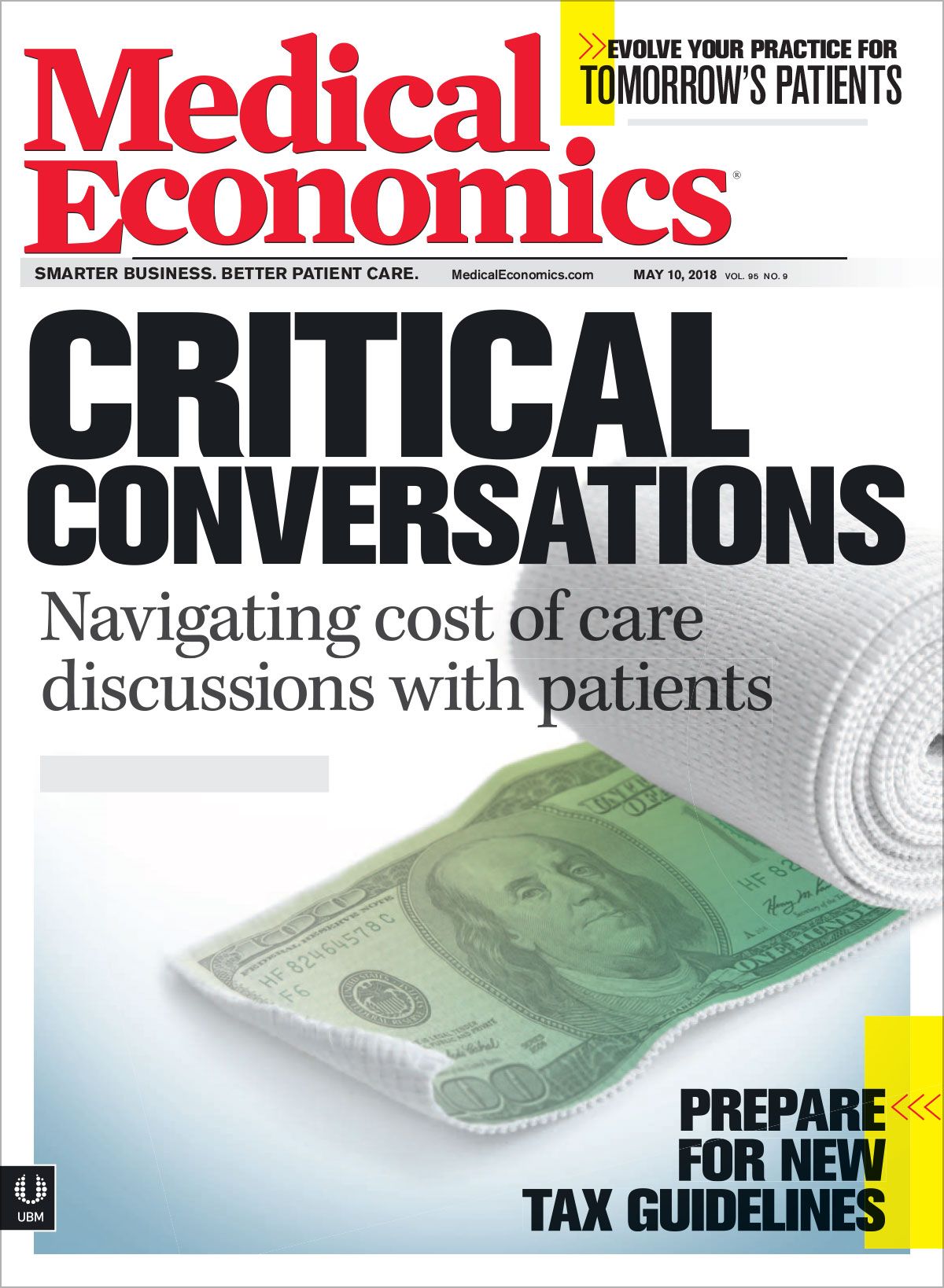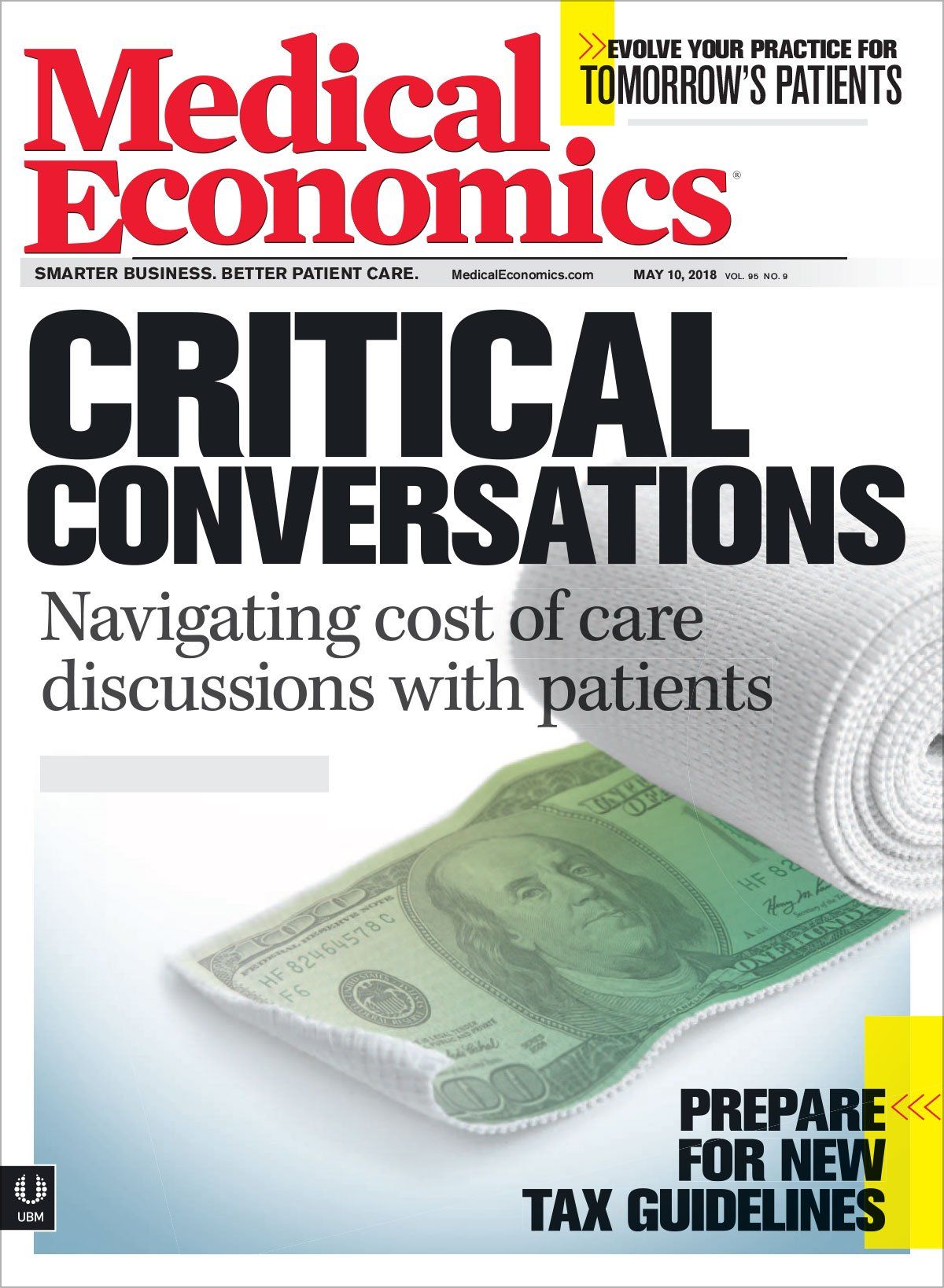Publication
Article
Medical Economics Journal
Navigating cost-of-care conversations with patients
Author(s):
Financial discussions with patients don’t have to be uncomfortable for physicians
This article appears in the 5/10/18 issue of Medical Economics

For physicians trained to address the ills of the body and mind first, discussing costs of care with patients may feel outside their typical role. Thus, physicians may put off these conversations because they are unsure how to handle them.
However, patients are increasingly interested in knowing what they will pay in advance. The price of health insurance premiums has increased by 55 percent in the past decade, according to a 2017 Kaiser Family Foundation report. As a result, patients are facing greater out-of-pocket expenses and more high-deductible health plans. This requires physicians to conduct more conversations about costs of care with patients.
Fortunately, several organizations have begun to develop scripts and approaches for physicians to tackle these conversations with greater confidence. That is important, as not discussing costs of care can have a negative impact on patients’ likelihood of getting necessary treatments or medications, according to a 2016 study published in Health Affairs.
“There’s this ivory tower [notion] in medical school that money doesn’t matter; just do what’s right for the patient,” explains Dustyn Williams, MD, a hospitalist and internal medicine clerkship director at Baton Rouge General in Baton Rouge, La. While he agrees that “doing what’s right” for the patient’s care is most physicians’ goal, “the reality is that healthcare costs are really high. And physicians don’t have that education until they get into practice.”
Indeed, in a 2016 study by the Society for Medical Decision Making (SMDM), physicians only discussed medical costs with patients about 30 percent of the time; and of those discussions, only about 40 percent included conversations in which physicians and patients sought alternatives that would save costs on medications or tests.
The study also found that 59 percent to 80 percent of patients want to discuss out-of-pocket costs during their visits with physicians, and 91 percent of physicians believe that managing patient costs is important.
Emmy Ganos, Ph.D., program officer at the Robert Wood Johnson Foundation (RWJF), says the foundation was inspired to take action after reviewing the SMDM study results. “Typically those conversations [about costs of care] were short, some as little as a minute, but when done well, they resulted in changes that were really important to care plans or advice for how to find a drug less expensively,” she says.
The study suggests four strategies physicians can bring up with patients to help lower costs without changing the care plan:
- changing logistics of care, i.e. the timing, source, or location;
- facilitating co-pay assistance;
- providing free samples; and
- changing/adding insurance plans.
In addition, the study recommends four strategies for reducing costs by changing the care plan:
- switching to lower-cost alternative treatment or test;
- switching from brand name to generic medications;
- changing medication dosage/frequency;
- and stopping/withholding interventions for a time to allow a patient to save up.
Ganos says that these strategies can provide physicians a roadmap to help patients reduce their costs.
The RWJF has partnered with Avalere Health, a Washington, D.C.-based healthcare consulting firm, on a research project called “Key Steps to Improve Patient-Clinician Cost-of-Care Conversations.” The foundation also funded eight research studies to help physicians and care teams improve these conversations and hopes to publish their results later this year or early in 2019, Ganos says.
“We feel it’s important to have these conversations while a patient is receiving care/making decisions about care,” Ganos says. This is because sometimes a cost conversation may involve switching a care approach or medication “and that should be made with providers.”
One reason physicians may avoid cost conversations is a lack of transparency about costs to patients from payers, according to Williams. This forces practices and patients to go through lengthy pre-approvals, he says.
There have been efforts to legislate greater transparency-and price transparency tools exist, such as apps and even programs that can be integrated into an EHR-but there’s a long way to go until full transparency has been achieved.
Standardizing the conversation
To help doctors and patients, several healthcare organizations, including the American College of Physicians (ACP), are working to standardize these cost-of-care conversations, even providing sample scripts to empower both physicians and patients.
Cynthia D. Smith, MD, vice president of clinical programs at the ACP, points out that providing a script also helps physicians avoid any implicit bias they may have about which patients are likely to need financial assistance.
“You have to be careful to not make assumptions about people,” Smith says. “You can’t really assume that one patient might have a problem paying for care; you have to ask.”
The ACP has developed a “high value care initiative” that walks physicians through a patient encounter with specific guidelines that include addressing cost-of-care issues. One step is to screen for “logistical and financial barriers to care” with questions such as:
- Are you worried about how your care will be paid for?
- If so, how can we help you with these problems?
- Do you have difficulty getting to appointments or medical tests?
The last question is of great importance to Ganos and colleagues at the RWJF because they’ve found that social determinants of health also play a big role in patients getting treatment. Those kinds of costs are a big unmet need,” Ganos says.
In addition to guiding physicians on how to be sensitive to patients’ financial needs, Wendy K. Nickel, MPH, director of the Centers for Quality and Patient Partnership in Healthcare at the ACP, points out that standardizing the process leads to greater shared decision-making between physician and patient. A standardized script can enable physicians to become better educated on the costs of treatments, procedures and medications.
Ganos points out these conversations don’t always have to be solely up to the physician, but should happen within care teams.
She’s seen the importance of engaging other staff members, such as receptionists, who field a lot of cost-related questions, or nurse practitioners and medical assistants. Ganos encourages physicians to work with their staff to put together a list of answers to frequently asked questions in advance of patient visits.
It might also be helpful for physicians who are engaging in a greater number of conversations about cost of care to remember that patients have more cost sensitivity than they used to, says Nickel. “What they’re really interested in is not what the charges for giving certain tests or treatments are, but what they’re going to have to pay out of pocket.” That, she says, is “a very complicated answer to come up with.”
Become a patient advocate
Linda Girgis, MD, a primary care physician in South River, N.J., makes a point of helping her patients find out the costs of tests and medications she prescribes to ensure that they follow through on their treatments.
“The way I look at it, if a patient needs a test, they need a test,” Girgis says. “My medical advice is not going to change, but it’s not helpful to them if they can’t pay to get it.”
She explains to them that they have the right to know price information up front before they get a test or a treatment. “I tell them to shop around, to ask for prices and be sure they know their coverage.” She says her patients feel better knowing she is advocating for them.
Girgis recommends physicians take the time to find some key resources to help patients and have those accessible during visits. She suggests keeping phone numbers on hand, such as those for the local facilities that perform certain tests, as well as those of social workers who can help patients find financial assistance.
Williams sees more pressure on physicians to add more tests and treatments, refer out, and even get unnecessary testing. He hopes physicians can push back against this pressure particularly when a patient is concerned about being able to afford their treatments or medications.
He encourages physicians to prescribe generic medications whenever possible. Though, he acknowledges, this can be difficult for physicians who are getting pressure from pharmaceutical reps and even their own medical systems to prescribe brand- name drugs. He takes the approach that the patient and the physician are a team and physicians should try to be a patient’s advocate at all times.
If a patient is resisting a medication or treatment the physician has prescribed due to fear of its cost, he urges physicians to be sensitive to the patient’s financial status. “Having those conversations isn’t about questioning the physician’s decision, it’s about questioning this gargantuan broken system that both the physician and patient have to work within.” The goal is to get the patient the best treatment option they can afford.
If cost-of-care conversations feel awkward, Ganos hopes physicians will use scripts and encounter models such as those created by the RWJF and the ACP until it becomes second nature.
Patient resources
Equally important to ensuring open communication around costs of care is empowering patients to ask the right questions, says Ganos.
She directs patients to a document published by the non-profit Consumer Health Choices, on five questions patients should ask their doctor before a test, procedure, or treatment. The questions are:
- Do I really need this test or procedure?
- What are the risks?
- Are there simpler, safer options?
- What happens if I don’t do anything?
- How much does it cost?
Nickel urges physicians to remind their patients to familiarize themselves with the mechanisms of their health insurance plans. “If you have a high-deductible health plan, what are the implications if you paid off your deductible late in the calendar year and then require some sort of expensive treatment? Although it might be covered in December, if you wait until January of the next year, you will have to pay out of pocket. It’s important to know those kinds of things,” Nickel says.
Websites such as Healthcare Bluebook allow patients to plug in the cost of specific insurance premiums and compare them to other premiums online. Apps such as GoodRx and Amino offer some price comparisons for some treatments and procedures, but not all.
However, Ganos says that it’s a lot to ask of patients to use these tools on their own.
“Patients making decisions in the absence of a provider may prove to be less than helpful to their care,” she says.
2 Commerce Drive
Cranbury, NJ 08512
All rights reserved.






